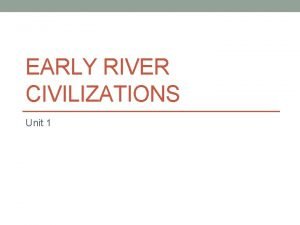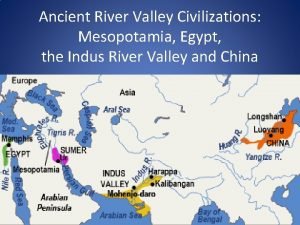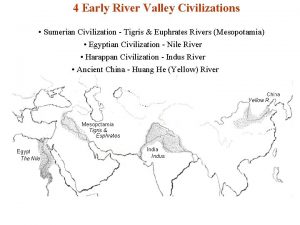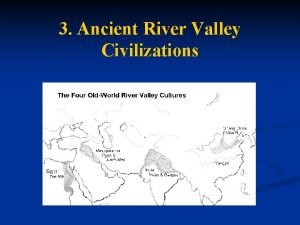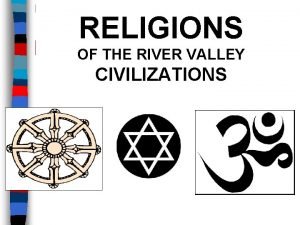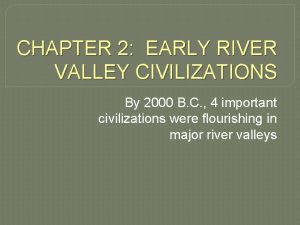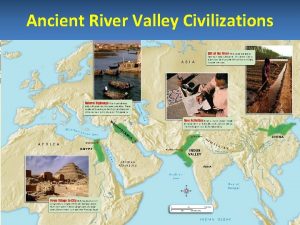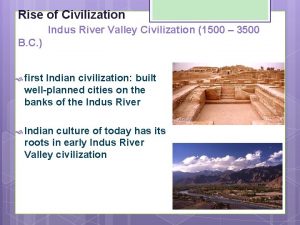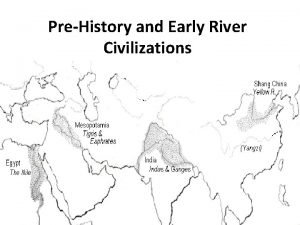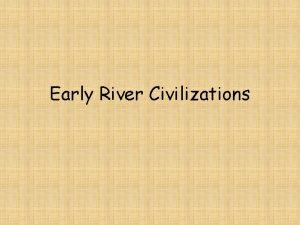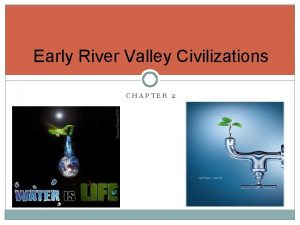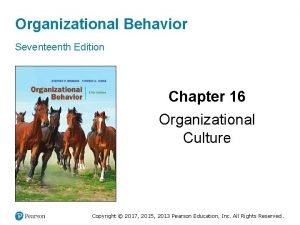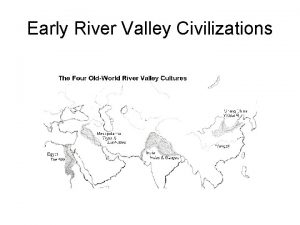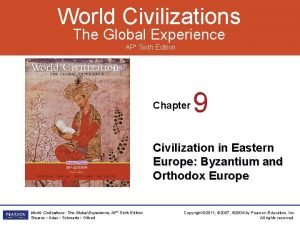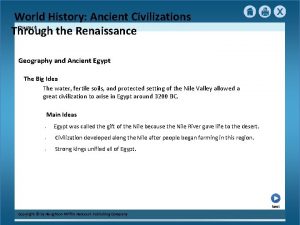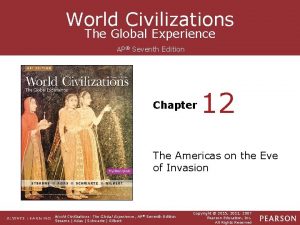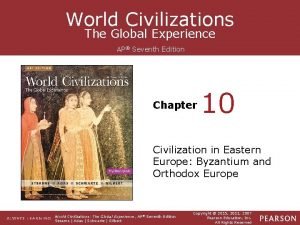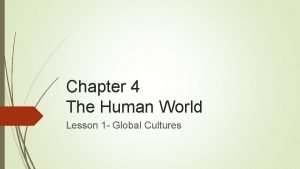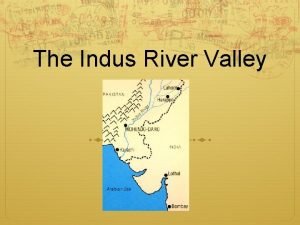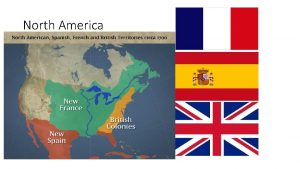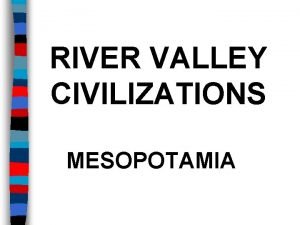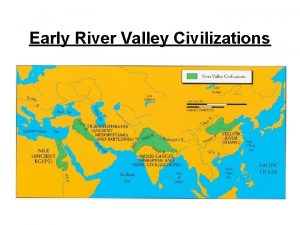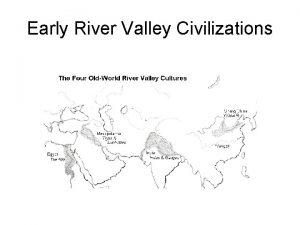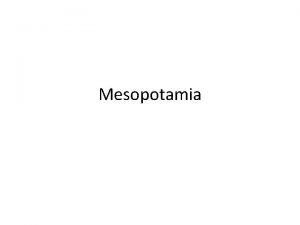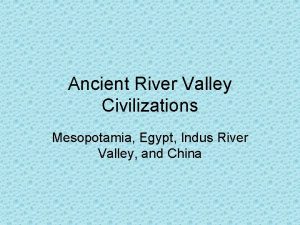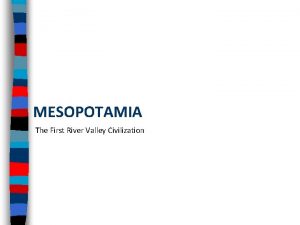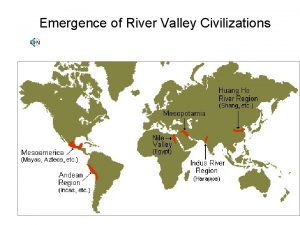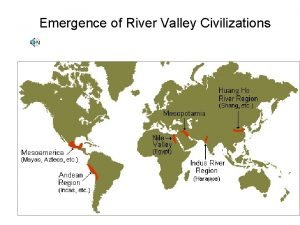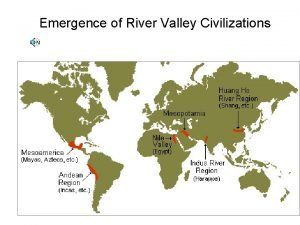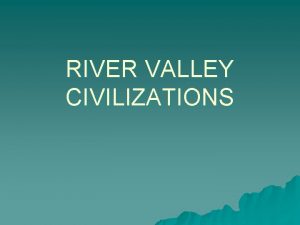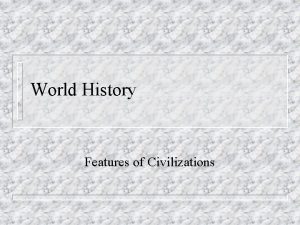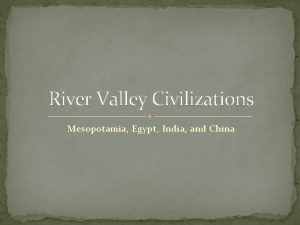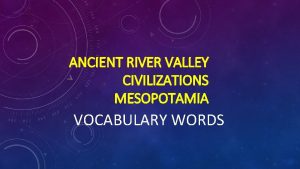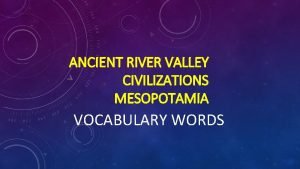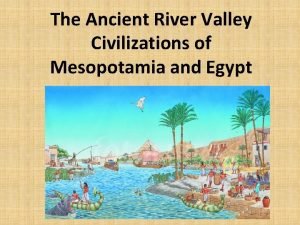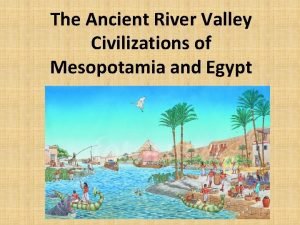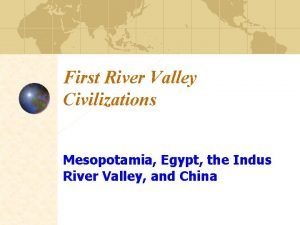RIVER VALLEY CIVILIZATIONS Mesopotamia World Cultures Mr Lauta























- Slides: 23

RIVER VALLEY CIVILIZATIONS Mesopotamia World Cultures Mr. Lauta


MESOPOTAMIA 3500 B. C. – 1700 B. C. • “Land between the rivers • Earliest known civilizations developed along the Tigris and Euphrates rivers • Middle East – Present-day Iraq




MESOPOTAMIA: The Cradle of Civilization • Around 4000 B. C. groups migrated into Mesopotamia • Developed many new ideas that the area has been called the “cradle of civilization” – Lasting impact on the ancient world

MESOPOTAMIA: Contributions • • Writing Codified laws Wheel Plow Sailboat 12 -month calendar Mathematics Clock

MESOPOTAMIA: The Rise of Sumer • People who settled in southern Mesopotamia were called Sumerians • Earliest known civilization on Earth • Controlled the effects of floods – Built levees – Put holes in levees so crops watered

MESOPOTAMIA: The Rise of Sumer • A system of irrigation canals took planning so people had to work together • People became more organized and set up governments to make laws • As population grew, began to build cities – Mud and crushed reeds – Sun-dried bricks

MESOPOTAMIA: The Rise of Sumer • Each Sumerian city was considered a state in itself – Made up of the city and farmlands – Each city-state was surrounded by a wall – Upper class lived in the center of the city • City-states often fought each other – Boundary disputes – Prestige

MESOPOTAMIA: The Rise of Sumer • At center of each city was a temple called a ziggurat – “Mountain of god” or “Hill of heaven” – Home of the city’s chief god – Only priests could enter the temple • Courtyards surrounded the ziggurat – School – Markets – Business

MESOPOTAMIA: The Rise of Sumer • Practiced polytheism – Forces of nature they could not control so they were viewed as gods – At first had only male gods then female gods appeared • Humans created to please the gods as servants • If gods were unhappy, natural disasters occurred • Only priests knew the will of the gods

MESOPOTAMIA: The Rise of Sumer • Schools were only for the sons of the rich • Known as tablet houses – Purpose of school was teach students to write – Cuneiform • Wedge-shaped writing • Developed to keep track of business deals

MESOPOTAMIA: The Rise of Sumer • Male-dominated culture – Head of household – Divorce power – Sell members into slavery – Arrange marriages • Women could run businesses and handle slaves in husband’s absence

MESOPOTAMIA: The Rise of Sumer • Sumerian priests were also kings – Advised by an assembly • In wartime, a member of assembly was selected to run government as king until peace established – Eventually permanently replaced priests as rulers • Kingship became hereditary

MESOPOTAMIA: Later Empires • About 2400 B. C. power of Sumer began to fade – Conquered by nearby people

MESOPOTAMIA: Akkadian Empire • Sargon I – Ruler from central Mesopotamia called Akkad – Around 2300 B. C. moved armies south toward Sumerian city-states – King of Akkad and Sumer – Created the world’s first empire • Empire lasted until his death • Individual city-states rose to power

MESOPOTAMIA: Babylonian Empire • Around 1800 B. C. a group of people called the Amorites entered Mesopotamia – Built own cities – Babylon was its largest city • King of Babylon, Hammurabi conquered Akkad and Sumer

MESOPOTAMIA: Hammurabi of Babylon • As conqueror, he took the Sumerian gods and gave them Babylonian names • Extended empire into the Mediterranean area • Reforms – Irrigation systems – Raised Babylonian gods above other gods – United people – Taxing system – Government housing programs His reign was known as the Golden Age of Babylon

MESOPOTAMIA: Hammurabi of Babylon • Best-known reform was a code of laws – Took all the laws of the city -states and took the best ones to make a single code of laws for the whole empire – Carried out fairly and justly – Innocent until proven guilty – Punishments ranged from fines to death, no prison – Upper class punished more severely


 Ancient river valley civilizations map
Ancient river valley civilizations map Ancient river valleys map
Ancient river valleys map 4 river valley civilizations
4 river valley civilizations 4 river valley civilizations
4 river valley civilizations Ancient chinese civilization
Ancient chinese civilization River valley civilizations religion
River valley civilizations religion Chapter 2 early river valley civilizations
Chapter 2 early river valley civilizations Civilization ppt template
Civilization ppt template Indus river valley timeline
Indus river valley timeline River valley civilizations map
River valley civilizations map River valley civilizations vocabulary
River valley civilizations vocabulary River valley civilizations characteristics
River valley civilizations characteristics Longest river in the world
Longest river in the world Chapter 2 early river valley civilizations
Chapter 2 early river valley civilizations Organizational cultures often reflect ________.
Organizational cultures often reflect ________. Code of hammurabi
Code of hammurabi World civilizations the global experience ap edition
World civilizations the global experience ap edition World civilizations the global experience 7th edition
World civilizations the global experience 7th edition Ancient civilizations through the renaissance
Ancient civilizations through the renaissance Twantinsuyu
Twantinsuyu World civilizations the global experience 7th edition
World civilizations the global experience 7th edition Lesson 1 global cultures
Lesson 1 global cultures Ganges river valley
Ganges river valley Pinckney's treaty
Pinckney's treaty

